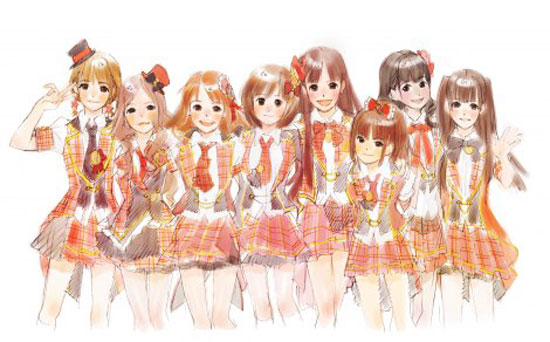AKB48 is a massive girls idol group (in fact, they hold the Guinness World Record for the “largest pop group”) based in Akihabara, Japan. But you could learn that from Wikipedia and it doesn’t really tell you much about them.
Even some fans of AKB48 think that the group has only been around for a year or two, but in fact the group got its start back in 2005 when a man named Yasushi Akimoto had an idea. Akimoto was no stranger to the music industry in Japan, having created the popular Onyanko Group in the 1980s. But his idea was for something very unique, to create a group of “idols you can meet.”
In Japan, the word "idol" is used for pretty much any talent who is popular and appears often in mass media. They could be a singer, an actor, a TV personality, or a model. The term can be used for both males and females, although it seems to be used more often with girls. All idols are celebrities, but not all celebrities are idols. The perception of idols has changed over the years, but currently idols are presented as fairly average people who just have a little extra something to make them popular. It is not uncommon for idols to be sort of one-hit wonders, being everywhere for a few months and then suddenly dropping off the radar entirely. Idols are held to a fairly high standard in terms of behavior, especially in larger idol groups where members graduate from the group and new members are added on a fairly regular basis. If you are at all a fan of Japanese pop culture you probably know of some idol groups such as Morning Musume, SMAP, Arashi, KAT-Tun, C-ute, and S/mileage.
 |
| This is Arashi. They are also super popular. |
Akihabara is often called Akiba for short and thus the group was called AKB (AKiBa) after the location of their stage. There is debate over where the 48 in their name came from. At one point the group did have 48 official members, but that number has since grown to many more and it doesn’t’ seem like 48 was originally the desired number of members (although it was much easier to explain to people when they had 48 members…). I’ve heard that the 48 is a play on Akimoto’s first name and is more of a brand label than a desired number of members.
But moving on, or rather, back to the history, they held auditions and 20 girls made their first performance in December of 2005. Many of the girls had little to no previous dance or singing training. In fact, the opening of their theatre was delayed for a week when it was decided that they were still not ready to put on their debut performance. But the girls worked hard and practiced and performed everyday and multiple times on weekends. A large draw for fans of AKB48, and other idol groups, is seeing the members grow and improve over time and watching their hard work pay off. In early 2006 auditions were held for the second generation of AKB48 members. The original members became known as Team A with the second generation known as Team K, and the teams took turns on stage on different days. In late 2006 Team B was added to the mix.
It wasn’t until 2009 with their 14th single “River” that AKB48 got their first #1 hit on the Oricon charts. This is when the group’s popularity really took off. And boy did they ever take off. You honestly cannot live in Japan and not know who these girls are. They are everywhere. With multiple teams they can perform in different parts of the country and still have a show going on at their theatre. The girls are often on TV, both on their own shows and appearing as guests on talk and variety shows and in various dramas and commercials. They appear in advertisements, in magazines, in movies, and in fashion.
The 48 phenomenon hasn’t stopped growing either. In late 2008 SKE48 was formed in Nagoya where they have their own theatre in the Sakae area. NMB48 popped up in 2010 based in the Namba area of Osaka. And in 2011 the most recent sister group was formed in the Hakata area of Fukuoka, HKT48. These sister groups are similar to AKB48, with their own stages and daily shows, although the members are not nearly as popular yet (with a few notable exceptions). The group even has some international sister groups with JKT48 in Jakarta, Indonesia and groups planned for Taipei and Shanghai (TPE48 and SNH48).
But AKB did not stop holding auditions. Although they did not add more teams, girls were added as Kenkyuusei, which you will usually see translated as trainees or research students. They are basically the understudies for AKB48. They practice with the group and learn the routines so that if members are absent from the stage performance due to illness or other commitments they can stand in for them. When members of AKB48 leave the group these research students have a chance to be promoted to take their place.
Girls can leave the groups in one of two ways. Girls who break their contracts get a sort of dishonorable discharge from the group. They leave, often with only a brief announcement that they have left the group. Most recently two members had to leave as it was discovered that they had been dating, which is against their contracts. Often no explanation is given as to why these members have been let go. Of course, at any time, members can decide to retire from the group, an event which is called graduation in the idol world. Some girls leave to focus on their studies, others to pursue solo careers, others because they just want to retire from being idols. Graduations are usually given a lot of fanfare, with the girls often having a performance dedicated to their graduation with the opportunity for them to speak to their fans and thank them for all of their support.
When AKB48 first started out girls graduated from the group fairly frequently. Girls joined, enjoyed a year or two as a member and then moved on. From the original 20 members, only 5 are still active in the group (with another to graduate soon). However, once AKB48 exploded in popularity graduations became far less frequent. There were a number of research students who had many fans due to their hard work on the AKB stage but were still not official members of the group. So in 2011 Team 4 was announced and it seems likely that a Team 8 will be formed soon.
Since the entire premise of the group is having idols that you can meet, they do a lot to promote the different girl’s personalities and interests. A few of the girls are even known for being a bit bratty or cold, with others having more traditionally attractive qualities like being energetic or kind. With so many members it is difficult to promote them all, and it is often left up to the girls themselves to find ways to promote their individual images through blogs and interactions with the fans. The group holds regular handshake events where, by buying AKB merchandise, usually CDs, you can stand in line for several hours with tons of other people and shake your favorite member’s hand. It seems a bit silly, but it is an opportunity for many to get some actual face time with someone they admire, however short it may be.
So far the group has released 25 singles with their 26th coming out at the end of May. However, the group has well over 100 songs in their repertoire as each Team performs a different show and most are on their fifth or sixth stage show. For most of the singles Akimoto (who also writes the lyrics for AKB48's songs) chooses the girls who will participate. But fans were unhappy with this, as they disagreed with certain girls being left out.
Fans are given an opportunity to have a say in the member lineup of one single each year. AKB48 and all of its domestic sister groups participate in a general election (which would better be described as a popularity contest). Fans get codes that can be used to vote for their favorite member in the newest single or for being a member of the official fan club. The rankings the girls receive in the election determines the lineup for the next single. Many fans buy multiple copies of the single so that they can vote for several girls. The total number of votes in last year’s election was over 1 million, and there is no telling what will happen at this year’s election.
The only other single whose members are not handpicked by Akimoto is the one following the annual rock-paper-scissors tournament. Members compete in a televised single round elimination tournament. The winner gets the center position for the following single along with the girls who advanced to a high enough round. This gives girls who are not often in the front a chance to show their stuff.
While it is easy to look at the whole 48 concept as a giant marketing scheme it is also worth looking at the work that the members have done. In the beginning the girls often performed for near empty theatres and it took a lot of dedication for them to continue with the group. Their popularity did not happen overnight and the girls had to work very hard for years to get where they are. AKB48 has also done a lot for the areas effects by last years earthquake frequently visiting the area to visit schools and hold concerts to cheer people's spirits, holding a massive donation drive and even donating some of their own salaries to the relief effort (they're rasied over 1.25 billion yen). Love them or hate them, its impossible to deny the heart and determination these girls have.


_cover.jpg)













Thank you! I didn't understand wikipedia ><
ReplyDelete